All in One Day: What Happens on Campus
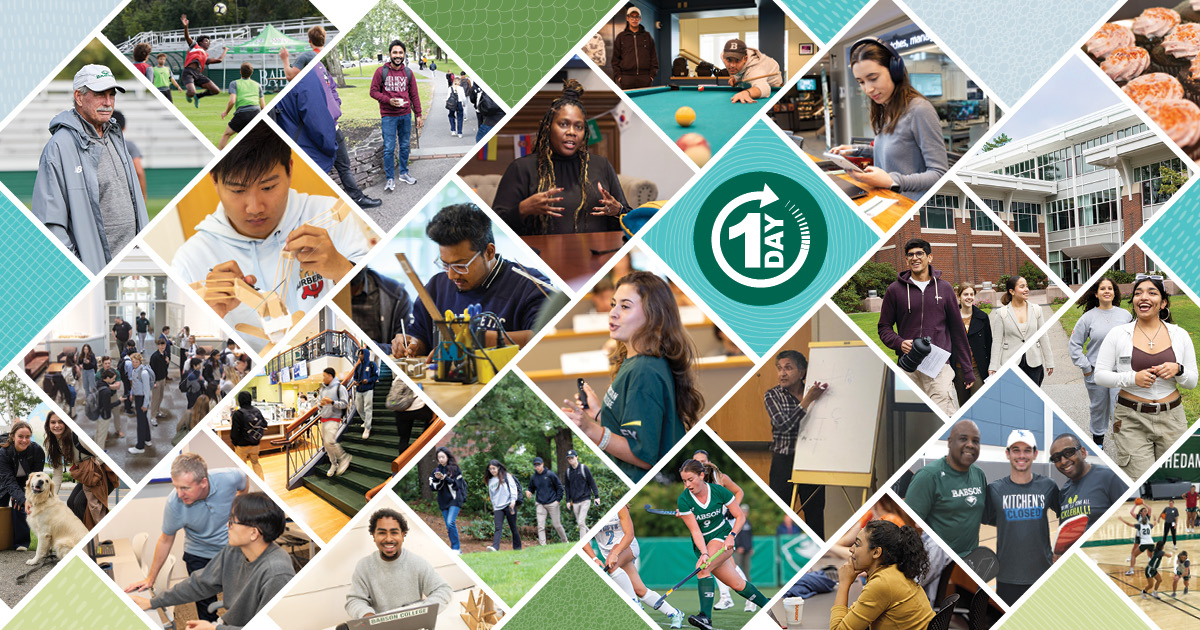
It’s quarter past 7 on an overcast Tuesday morning in late September on the Babson College campus, and Jon Anderson ’75, P’04 ’08 ’13 ’13 is walking from the parking lot toward the Len Green Recreation and Athletics Complex (LGRAC), briefcase and coffee in hand.
It’s a walk he has made countless times before, and it’s the start of a long day for Anderson, now in his 38th season as the men’s soccer coach. His team has practice at 2:30 p.m., and he will be working into the evening because it’s recruiting season.
BABSON MAGAZINE: Read the complete Winter 2023–2024 issue.
“It’s great to come in here, especially early in the morning. It’s quiet. You can get work done,” says Anderson, also the senior associate athletics director who oversees the athletics buildings. “I love coming to work. This building is so amazing. Let’s face it, the whole campus is like this. There’s a lot of pride from anyone who works here on this campus.”
It’s also the start of a busy, hectic day on Babson’s Wellesley campus. From early morning workouts to a marathon volleyball match, from Foundations of Management and Entrepreneurship at Tomasso Hall to an evening graduate marketing class at Olin Hall, from community reflections to performance rehearsals, it’ll be a jam-packed day, which is to say it’s quite a normal day.
“Everyone should see what happens on campus in a day,” Anderson says.
7:07 a.m.: Len Green Recreation and Athletics Complex
Even before Anderson’s arrival, LGRAC is buzzing as 35 members of the swimming and diving team work out in the recreation center while others are swiping their OneCards on their way to the weight room.
“It’s a steady flow of students and community members,” says LGRAC supervisor Scott Kaufman, who arrives at 5:30 a.m. on weekdays and is manning the front desk alongside Anush Korantana ’24.
8:38 a.m: Babson Commons at Horn Library
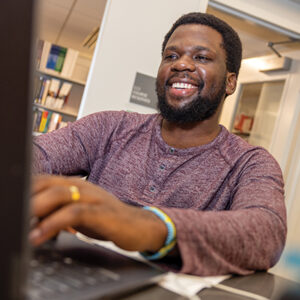
About a dozen students sit at the Ralph Z. and Charlotte X. Sorenson Atrium, including Brianna Torres ’26, who is preparing for her Financial Analysis and Reporting class at 9:45. “I love coming here because it’s so pretty,” she says, with her laptop, notebook, and coffee all in reach.
Upstairs at Horn Library, 14 students are scattered amid the tables, chairs, and study rooms. Manny Nsanganwa ’24 covers the front desk, ready to provide information or the occasional laptop or phone charger, while doing his own homework for Climate and Economic Systems.
Patrick O’Hanlon, the access services librarian, says the library is a popular place. “It’s very energetic,” he says. “It’s a second social center on campus.”
9:30 a.m.: Olin Hall
This is a nice time for a class—early, but not too early. Students file into the room, many carrying cups of coffee and bottles of juice. “Everyone starts fresh,” says Linghang Zeng, assistant professor of finance. “Everybody is ready for discussion.”
After starting with a rundown of the latest financial news, the “talk of the day” as Zeng puts it, the class turns to a lesson on loans. This being a fintech course, Zeng looks at how tech companies are affecting mortgages, student loans, and car loans.
Tech promises disruption, but that’s not always what transpires. “Every market is unique,” Zeng says. “Every market has its own unique perspective.”
9:54 a.m.: Finance Lab
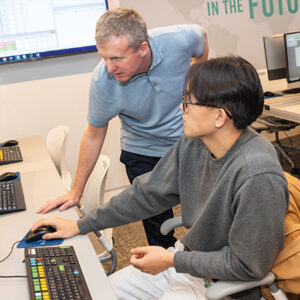
No one is talking inside the Stephen D. Cutler Center for Investments and Finance’s lab, but there’s plenty of activity. A symphony of mouse clicks fills the room as students practice principal trading during an advanced class on financial trading strategies and risk management. The course makes use of the finance lab’s 42 workstations, equipped with Bloomberg, FactSet, and trading simulation software. These essential finance industry tools allow students to get hands-on experience, working with the same equipment as professional traders.
Babson Professor of Finance Ryan Davies moves about the room. Occasionally, his voice cuts through the clicks. “I’m noticing that a lot of people don’t have their graphs out,” Davies says, referencing the candlestick charts showing market volatility and price trends. “I really want to recommend using them.”
This exercise is a rehearsal for an important trade performance evaluation next week in which students will be graded on their performance relative to each other. Lillian Lu ’24 leans toward one of the massive 34-inch curved monitors and briefly furrows her brow. Her screen has no fewer than 13 open windows, with offers to sell or buy coming in by the second.
“If you remember, this iteration is the one with the less favorable tenders. You might want to be a little picky about your tenders,” Davies says. Lu’s mouse stops clicking. She decides to hold off on an offer to buy.
“Sometimes, the hardest thing about being a trader,” Davies says, “is to do nothing.”
10:20 a.m.: Park Manor Quad
D.R. Widder MBA’99 crosses the Quad following a leadership meeting. For the College’s vice president of innovation, campus life never ceases to inspire.
“You can strike up a conversation with anyone on campus, and they are working on some amazing idea,” Widder says. “I am always inspired to do a little bit more, to aim a little bit higher, because they are as well.”
10:50 a.m.: Olin Hall
On the second floor, light shining down from the glass ceiling above, David Echauri MBA’25 sits at a table by himself. He’s reading a case study on Apple, and he has a little over an hour until he meets his learning group to discuss it.
To help concentrate, he’s listening to music, a playlist called “Focus Flow,” as headphones envelop his ears. Listening to music while reading, though, is a tricky business. The songs can’t be too distracting. “It has to be chill,” he says.
Find the right tempo, the right vibe, and he’s taken away. “You just space out,” he says. “You forget about things around you.”
10:58 a.m.: Lunder Undergraduate Admission Center

Valarie Jaquez ’25 is pointing and talking, demonstrating to four fellow students how best to show the campus on tours to prospective students. “I absolutely love the campus, which is why I give tours,” she says.
Today, there are only a handful of campus tours, but just the day before, there were about 200 people on campus tours, says Pamela Dietrich, who coordinates campus visits at the Lunder Undergraduate Admission Center.
Like Jaquez, Camila Martinez ’26 conducted tours for high school students last year before becoming Admissions Fellows this year. Martinez—whose mother, Mariana Palacios ’96, and grandfather, Carlos Palacios ’70, both are alumni—especially enjoys sharing her deep passion for Babson. “It’s so welcoming and engaging,” she says. “As a student, you feel like a person here and you feel invited to participate and to be yourself and to engage with others. It’s really fun to be here.”
11:06 a.m.: Horn Library
Read about the Undergraduate Center for Career Development’s popup table.
11:30 a.m.: Tomasso Hall
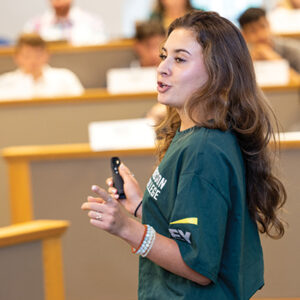
students present their business proposals during rocket pitch. (Photo: Nic Czarnecki)
A lot is going on in Room 308. Today, the students in Foundations of Management and Entrepreneurship, the hallmark Babson class better known as FME, are running through their rocket pitches. One by one, teams will stand in front of the room and present their business proposals.
Before they begin, music plays. “This is a big day, so we have the pump-up jams,” says Ben Spigel, visiting assistant professor in entrepreneurship, as “We Will Rock You” rings out.
A pile of candy is also available for students. “This candy is free game if you need extra energy before you present,” says Spigel’s co-teacher, Lucy Turner MBA’14, assistant professor of practice in management.
The presentations move fast, with teams given three slides and three minutes—and not a second more—to make their pitch. Spigel counts them off with a “three, two, one, go.” Their wide-ranging ideas include an on-campus delivery service, a washable laundry bag, a wellness platform, and not one but two proposals for golf balls that never get lost, one using thermal imaging and the other GPS trackers.
Ten teams present in all, and when they finish, Spigel says, “Give yourselves a round of applause.”
12:37 p.m.: LGRAC Recreation Center

An hour after the sun breaks up the gray skies, it’s heating up inside LGRAC, where the thwack-thwack-thwack sounds of three pickleball players fills the cavernous rec center.
Michael Bruny MBA’18, the manager of employee engagement, has been playing for two years and started organizing pickup pickleball games for staff and faculty about a year ago. Today, he’s joined by Lawrence P. Ward, vice president and dean of campus life, and Carmelo Carbone ’25, who plays every day and has started both a student pickleball group and a venture for pickleball attire and merchandise.
“Pickleball is made for everyone,” says Carbone, who is enjoying the chance to chat about the sport while rallying with campus figures. “It’s really great at school to connect with faculty and staff. Usually it’s meetings and classes, so to break out of that environment and really get to know these guys and play a fun sport with them is unbeatable.”
Carbone calls time so he can head to his Cultural Anthropology class, leaving Bruny and Ward to play one on one.
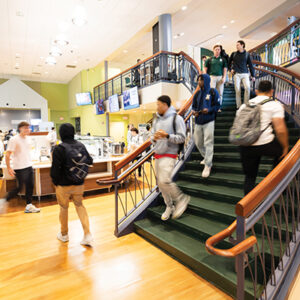
1:10 p.m.: Trim Dining Hall
The lunch rush is on. With midday classes letting out at 1 p.m., a stream of students makes its way to Trim. Soon enough, at the first food station at the bottom of the stairs, a short line forms. “I try to get out of class and get right here,” Max Gregoire ’26 says.
Today, the station has jerk chicken on the menu. “This has the best options,” Gregoire says. “I really go for the protein.”
Others in line have different favorites. Tiffany Ramsarran ’23 likes Trim’s zucchini and squash, while Mia Fierro ’27 enjoys the sweet potato. “It’s reliable,” she says.
Jefferson Wu ’27 goes for the mac and cheese. Also, the ice cream. “I try not to get it too often,” he says.
1:37 p.m.: Babson Executive Conference Center

As construction workers make progress on the renovations at the Herring Family Entrepreneurial Leadership Village, the robust discussion inside a classroom at the Babson Executive Conference Center is about gorillas, chimpanzees, and monkeys.
Professor Jay Rao P’21 ’24 teaches the course Leading Innovation: Gorillas, Chimps, and Monkeys as an MBA elective and in executive programs. Today, though, he is faculty director for a Babson Academy for the Advancement of Global Entrepreneurial Learning program called Think and Act Like a CEO: Entrepreneurial Leadership & Innovation.
More than two dozen part-time MBA students from HHL Leipzig Graduate School of Management in Germany are immersed in a two-day session at Babson, one of four stops on a weeklong visit to top Boston business schools.
As always, the primates are at the forefront of Rao’s discussion. They represent “how large companies, medium companies, and small companies compete and innovate differently,” says Rao, who has a tattoo of a gorilla, chimp, and monkey on his forearm. “Ideally, you want to be a gorilla, think like a chimp, act like a monkey, which is super hard to do.”
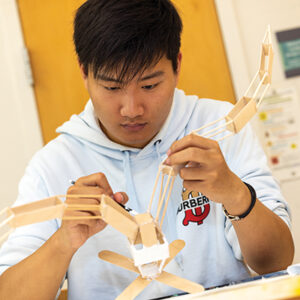
1:40 p.m.: Sorenson Family Visual Arts Center
Art and creativity are the business at hand in Room 215. As students pass around bottles of paint, artist and adjunct lecturer Olivia Baldwin talks about the use of colors. Blend them together, she advises. Create something new. “My rule is if you’re using color, it’s got to be nuanced,” she says. “It’s got to be mixed.”
Baldwin is teaching Intro to Sculpture, and students are working on their latest projects, structures made of wood and cardboard, some standing sturdy and straight, others twisting and turning.
Today, students are adding to their creations, with paint or gel or string. Glue guns and paint brushes are essential tools. “If you make a mess on the table, it’s OK,” Baldwin says. “We can clean it up.”
2:35 p.m.: Upper Athletic Fields
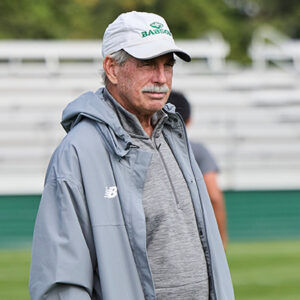
Anderson arrives at Hartwell-Rogers Field as his men’s soccer team begins its stretches, jogging, and drills. As a student-athlete, Anderson helped Babson win its first national championship in 1975. Now in his 38th season as coach, he’s molding a young squad, currently ranked 18th in the country. “It’s a really challenging schedule, so they’re experiencing what that means,” he says. It’s no exaggeration—the Beavers are preparing for tomorrow’s game against the third-ranked team in the country. (The next day, Babson will defeat Amherst, 2-1, on a goal by Ted Rosenfeld ’27 with five seconds left.)
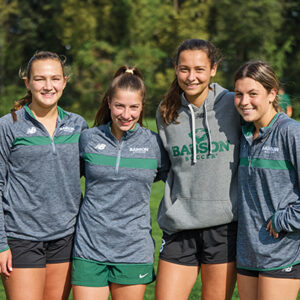
As the men’s practice moves onto Isbrandtsen Field, four women’s players are packing up. The women’s soccer team is getting the day off, but Cassie Lawson ’24, Olivia Maltbie ’24, Jordyn Ferrantino ’25, and Claudia Baiter ’27 have come out for extra training in preparation for a home game Saturday. Now, they’re heading to the trainer’s room, then dinner at Trim, then studying at the library. “Most of my time on campus is with the team in some capacity, studying together or practicing,” Lawson says.
Baiter has to put the finishing touches on her group’s rocket pitch in FME tomorrow. “I’m scared, and I’m not even the one (presenting),” she says.
2:45 p.m.: Weissman Foundry
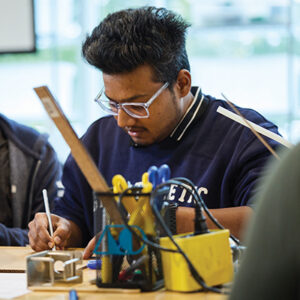
As the room buzzes with activity, Jonathan Griffiths addresses the MBA students huddled at tables. “I hate to be the bearer of bad news,” the Weissman Foundry director says, “but you have three minutes remaining.”
The Foundry is a place for creation and exploration, and the students, from a course called Entrepreneurship, are visiting for a prototype exercise. They’re hustling to create a toothbrush holder in 30 minutes.
The holders will be simple, with cardboard serving as the main building material, but the goal is to introduce students to the process of designing and developing products. “The whole point is to get your hands dirty on things,” says the teacher of the course, William Gartner, the Bertarelli Foundation Distinguished Professor of Family Entrepreneurship. “It’s about how you test ideas and make them real.”
4:15 p.m.: Reynolds Campus Center
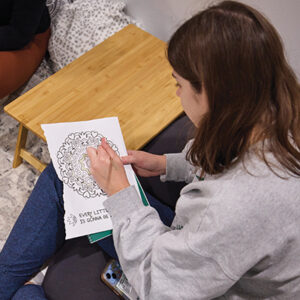
In a room located about halfway between the bookstore and the food market, all is calm and quiet. Outside this space awaits the hustle and bustle of Reynolds, but inside, several students lounge on bean bags, journaling and coloring, as rain sounds play on a speaker. A dream catcher and a tapestry hang on the wall.
“This is one spot on campus where it is truly relaxing,” says Alexy Berson ’26, one of the Peers on Wellness, a student group dedicated to promoting health and wellness on campus.
This is the Mindfulness Space, and it’s a place for students to study, to meditate, to take a nap, to decompress. “You can use it however you see fit,” says Sophia Eisenhaure, a coordinator with Babson’s wellness and prevention services. “It is a space to get away from whatever you need to get away from.”
4:35 p.m.: Glavin Family Chapel
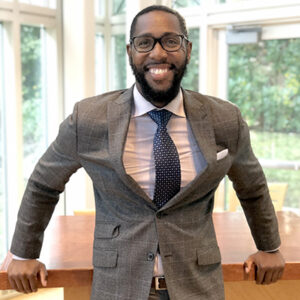
Darrell Hamilton, the campus’ protestant chaplain, is preparing for his weekly faith and life service. “There is a higher love that we cannot only practice for ourselves, but there’s a higher love that also is beckoning us and calling us that we can also be inspired by,” he says. “That’s the idea of tonight’s message.”
One of four chaplains with the multidenominational Office of Spiritual and Religious Life, Hamilton says, “The approach of the office is thinking about how spiritual and religious life helps to serve the holistic well-being of an individual.”
In addition to the weekly Tuesday service, Hamilton and the other chaplains are on campus for open office hours, available to talk with and counsel students on anything. “We’re moving into midterms,” he says, “so I suspect it’s going to be a lot more pop-ins.”
6:15 p.m.: Canfield Hall
For a community meeting, students gather in the living room of the Johnson House, a special-interest living space for Black students at Babson. The purpose of the meeting is to plan for future community projects that strive to lower the racial wealth gap. But first, one by one, students take time to speak about their personal stories.
They reflect on their upbringings, on the shortcomings they saw in their schools, on the lack of opportunities they and their friends and families faced. The conversation is honest and real. Sometimes, the truth hits so hard the residents snap their fingers in response.
“I grew up around people who didn’t take advantage of opportunities,” Katio Barbosa ’25 says. “I believe given the right opportunities and circumstances, they could have seen the value in themselves. That’s what we do at the Johnson House.”
The Johnson House means a lot to the students present. “I am forever grateful to be able to converse with everyone here, coming from similar situations as me,” Barbosa says.
6:17 p.m.: Olin Hall
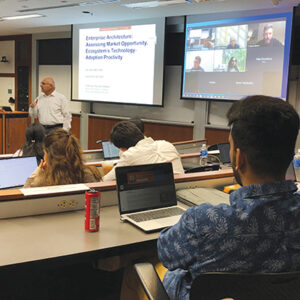
Professor Anirudh Dhebar arrives early at Room 102 to log in for his Marketing High Tech Products graduate class, which is taught in person and synchronously online. “It’s called webflex, or hybrid,” he says.
As students arrive for the 2½-hour evening class, others begin to appear on the large screen in the front (one of seven in the classroom). One of the 10 online is Rasmus Bramm MBA’24, who is logging in from Copenhagen, Denmark, at 12:30 a.m. local time.
Pavan Telapolu MBA’24 is one of 30 students in the classroom. He raves about Dhebar and the class. “I’m confident by the end of this class that I’ll be able to develop an entire marketing plan by myself, which is boggling for an MBA class,” he says.
During the class, Dhebar presses students to understand a company’s essence, its reason for being. “My reason for being is two things: to tease your brain and touch your soul,” he says.
6:33 p.m.: Diversity Suite, Park Manor Central
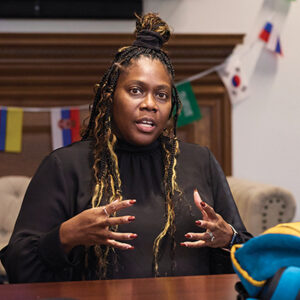
director of Multicultural and Identity Programs, leads a weekly community conversation. (Photo: Michael Quiet)
It’s dark by the time students start piling their plates with broccoli and ziti, chicken tenders, and salad. The Babson Pride Community Dinner, held in the cozy Diversity Suite in Park Manor Central, started late after a weekly community conversation went long. The dinner, held every Tuesday, is organized by Babson Pride, a student-run organization that supports the College’s LGBTQ+ community.
Natalie Joseph, the director of Babson’s Multicultural and Identity Programs who leads the weekly discussions, sticks around as the Pride dinner gets underway. Other students stay, too, including Julia Munoz ’25, a Justice, Equity, Diversity, and Inclusion (JEDI) Student Leader.
Munoz and her fellow JEDIs are tasked with ensuring that Babson’s community is socially just and equitable for all students. The first-generation college student says she started attending the weekly discussions when she was a sophomore.
“A lot of us have a close relationship with Natalie, so when she invites us to an event, we go,” Munoz says.
7:27 p.m.: MacDowell Field
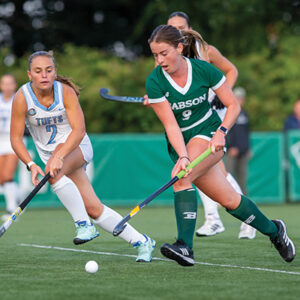
Under a sepia-toned near-full moon, the final horn blares and players rush the goal as Babson’s field hockey team celebrates a huge victory. The Beavers, ranked No. 2 in the country, have shut out fifth-ranked Tufts, 2-0, behind goals from Caroline DiGiovanni ’26 and captain Meara Hanyon ’23, MSF’24 and five saves by Bayla Furmanek ’25.
More than 125 fans have turned out for the game, including the men’s lacrosse team eager to take advantage of a Chick-fil-A giveaway for the first 99 fans.
8:05 p.m.: Sorenson Center for the Arts
Inside the Sorenson Rehearsal Studio and Black Box, a stark, unadorned space tucked away in a corner of the building, actors do the hard work of bringing words on the page to life. They have been rehearsing since 6 p.m., running through scenes over and over. Opening night of their play, Kingdom City, is well over a month away, but much polishing and perfecting remain to be done.
The Empty Space Theater, or TEST, a faculty-led theater company, is putting on the play. “Beautiful,” director Beth Wynstra tells the actors. “Let’s do a couple of notes, and then we’ll run it again.”
Rehearsing a production may be demanding, but it also transports actors far away. “You forget about anything else,” says Wynstra, associate professor of English. “No matter what is happening outside, you are fully present with each other.”
8:24 p.m.: PepsiCo Gym
It’s packed and raucous on the two indoor turf courts, where two high-pitched intramural soccer games are raising the temperature and intensity.
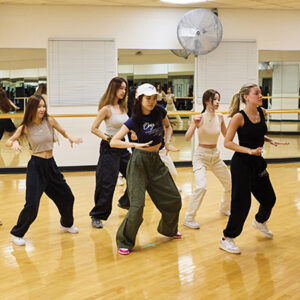
There are about 600 intramural athletes at Babson, including about 200 men and women undergrad and grad students who play soccer every Tuesday night “It’s fantastic. The biggest thing is it’s a sense of community, like soccer itself,” Aryan Mankar ’25 says. “Teams will bring their own fans, so it gets pretty fierce for intramurals.”
8:36 p.m.: Chandor Dance Studio
Inside the Chandor Dance Studio, Brianna Becerra ’25 leads eight other women in choreographing a dance routine to “Divaback” by Coryography. Becerra, president of the Babson Dance Ensemble, and her group are one of eight that rehearse once a week for two performances in early December.
9:12 p.m.: Staake Gymnasium

As the day winds down, the volleyball team is still hard at work. For the past two hours, it has been locked in a marathon match with rival Wellesley College. Finally, Erin Gray ’24 and Lulu McShane ’24 each record three kills in the fifth set to secure Babson’s ninth consecutive win.
The victory serves as an exclamation point to a long, bustling, rewarding day on campus.
Students learned and laughed. They created and collaborated. They won and celebrated.
It was a good day. Soon enough, another one was set to begin.
Posted in Community, Entrepreneurial Leadership






